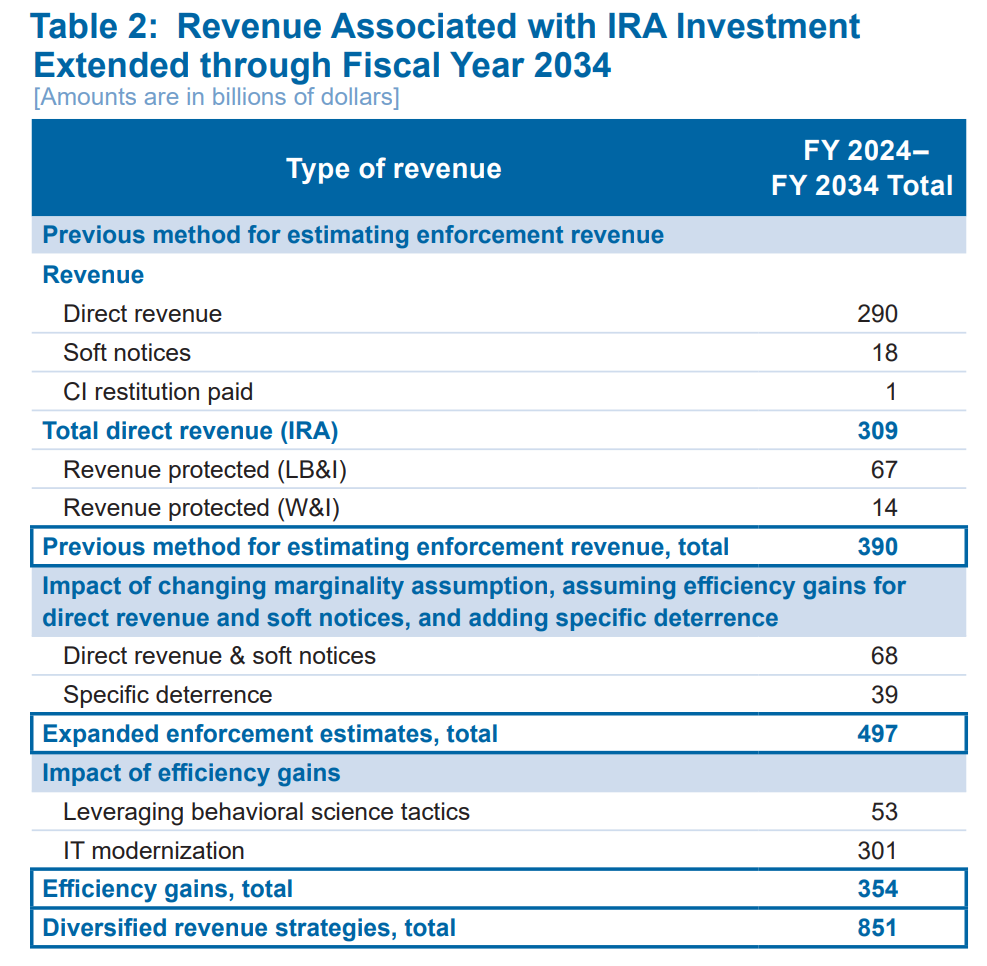Taxes
Treasury: IRS Could Collect $561 Billion in Revenue Thanks to Inflation Reduction Act
However, Treasury warned that if $20 billion is cut from the IRS’s funding allotment, it would reduce revenues by over $100 billion.
Feb. 06, 2024

A new Treasury Department analysis says the IRS could turn the nearly $80 billion in funding it’s receiving from the Inflation Reduction Act into $561 billion in overdue and unpaid taxes collected over the next 10 years, higher than earlier estimates.
In fact, the report states that if the Inflation Reduction Act funding is renewed after it runs out at the end of fiscal year 2031, estimated revenues could be as much as $851 billion. However, Treasury warned that if $20 billion is cut from the IRS’s funding allotment, it would reduce revenues by over $100 billion.
“While the IRS would still be able to ramp up enforcement against big corporations and wealthy taxpayers who do not pay what they owe in the next several years, the rescissions would cause IRA enforcement funding to run out in 2029— about two years earlier than it would have under the IRA as enacted—reducing the revenue raised in 2029 and subsequent years,” Treasury said in a news release. “The [Biden] administration has proposed extending and maintaining IRS investments after the IRA funds are exhausted, which would enable the IRS to collect $851 billion over 2024 to 2034. Conversely, additional rescissions of IRA resources or cuts to IRS base funding would further reduce revenue collections and could reverse taxpayer service improvements that have already been made and even endanger near-term enforcement efforts.”
Treasury said in the report that previous IRS estimates of Inflation Reduction Act revenues were limited to money brought in by direct enforcement activities resulting from higher enforcement staffing.
But those estimates “did not present a complete picture of the revenue benefits of the innovative investments we are making under the IRA SOP (strategic operating plan). The approach ignored many activities that will influence revenue, including enhancing services to improve voluntary compliance, modernizing technology, and adopting analytic advances that can dramatically improve productivity. It also ignored the deterrence effect of compliance activities on taxpayers’ behavior.”
Treasury continued, “To account for the potential revenue impact of the full array of investments contemplated in the IRA SOP, we need to look at the effects on revenue collection in a more comprehensive way. For example, we are improving our notices to make them more readily understandable and to reach people at an optimized moment, such as sending notices with resources prior to major tax due dates or following legislative changes that impact taxpayer population groups. We are also improving customer service to increase the likelihood that taxpayers will successfully connect with the appropriate resources to resolve their issue upon receiving a notice. Similarly, foundational investments in IT infrastructure will boost efficiency. We cannot ignore the benefits of these improvements.”
The report states that using previous methods for estimating enforcement revenue, the IRS would bring in $390 billion in revenue during 2024 to 2034. Improvements to the methods for estimating enforcement revenues would bump those estimates up to $497 billion. But under the more “comprehensive” way of revenue collection, the investments in IRS technology, data analytics, and taxpayer services would yield total revenue of $851 billion.
“Under the most comprehensive approach, the IRA investment, if sustained, will raise $851 billion over FY 2024-2034, which is more than double the estimates from the previous, overly conservative ROI estimation process. As enacted, the IRA would raise $561 billion over FY 2024-2034,” the report says.

In addition to its FY 2023 annual appropriation of $12.3 billion, the IRS received approximately $79.4 billion in supplemental funding over a 10-year period when President Joe Biden signed the Inflation Reduction Act into law in August 2022. Approximately $1.4 billion of that funding has been rescinded by lawmakers as part of debt ceiling negotiations earlier this summer. Another $20 billion or so will be cut and repurposed as part of the agreement last June between Biden and then-House Speaker Kevin McCarthy to suspend the debt limit and cap federal agency spending.
“This analysis demonstrates that President Biden’s investment in rebuilding the IRS will reduce the deficit by hundreds of billions of dollars by making the wealthy and big corporations pay the taxes they owe,” National Economic Adviser Lael Brainard said in a statement. “Congressional Republicans’ efforts to cut IRS funding show that they prioritize letting the wealthiest Americans and big corporations evade their taxes over cutting the deficit.”
The Inflation Reduction Act investments in the IRS were necessary because of a decade of deep funding cuts from Congress that resulted in unacceptable service levels, prevented technological upgrades, and undermined enforcement, particularly efforts focused on wealthy individuals and big corporations that failed to pay the taxes they owe, Treasury said. Driven by these funding cuts, the audit rate on millionaires fell by more than 70% from 2010 to 2019, and the audit rate on large corporations fell by more than 50% over the same period.
The tax gap—the difference between taxes owed and taxes paid—grew to $688 billion in tax year 2021.
The IRS said last month it has recouped roughly $482 billion in back taxes from rich tax cheats since last October because of improvements that have been made to modernize the agency using the Inflation Reduction Act funding.
